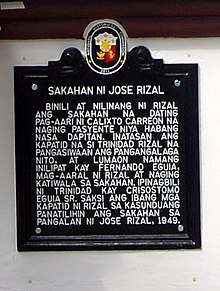José Rizal's farm
The farm of José Rizal (Filipino: Sakahan ni Jose Rizal) is a designated historic site in Katipunan, Zamboanga del Norte, Philippines.[1]

Origin
When Dr. Jose Rizal was deported to Dapitan in Mindanao from 1892-1896 by the Spanish government, aside from spending some time in teaching the town folks, he also engaged in medical practice through which he was able to cure the eye ailment of Calixto Carreon. The story said that Calixto offered Dr. Rizal the 40-hectare land as a way to repay him. Dr. Rizal accepted Calixto's offer, but insisted on a payment of ₱200, which he had won in a lottery organized by the Spanish.[2] Rizal planted coconuts, hemp, sugar cane, and fruit trees on his farm.[2]
In order to keep the farm under proper management, Dr. Rizal designated one of his sisters, Trinidad, to look after the farm. After several years, Trinidad passed the farm's management to Fernando Eguía, one of Dr. Rizal's students. A marker was installed in the area by the National Historical Institute (NHI) which states that Trinidad sold the land to Crisostomo Eguía Sr., son of Fernando. It was agreed right there and then after the sale that the land would still be registered under the name of Dr. Rizal. Other siblings of Dr. Rizal also witnessed such agreement.
At present days, the farm is under the care of the children of Crisostomo Eguia Sr. On a positive note, Director Mary June Bugante of the Department of Tourism Region 9 said her office is constantly in touch with Eguia Family to encourage them to transform the farm into a duly recognized tourist destination.
Tourism
The farm with the span of 40 hectares continues to attract visitors which are usually composed of group of students and tourists both coming from local and foreign places. However, at present there are no establishments built yet that would accommodate those visitors who wish to spend a couple of days within the area. Nevertheless, the Department of Tourism Region 9 is exerting more efforts on its desire to promote the heritage sites which Dr. Jose Rizal left in the historic lands of Zamboanga del Norte.
References
- "National Registry of Historic Sites and Structures in the Philippines: Dapitan - Sakahan ni Jose Rizal". National Historical Commission of the Philippines. October 2011. Retrieved 3 May 2014.
- Locsin, Teodoro M. (1996). Rizal. University of Michigan. p. 111. ISBN 971-91399-2-7. OCLC 36884621.
[A] ticket he had in the Spanish lottery brought him 6,200 pesos. He bought more land [...] On these rich fields he planted coconut, hemp, sugar and fruit trees. He became a gentleman farmer.
- "Jose Rizal's farm: A place to visit". Manila Bulletin. 16 February 2014. Retrieved 3 May 2014.